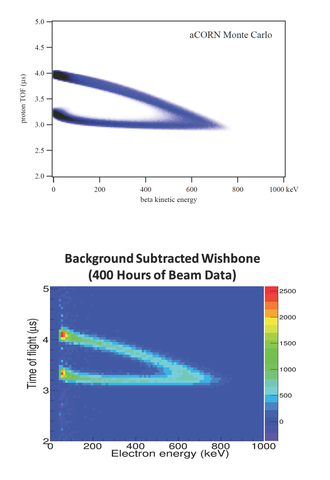Fundamental Physics: Measurement of the Electron-Antineutrino Correlation in Neutron Decay (aCORN)
Summary
The angular correlation between the beta electron and antineutrino in nuclear beta decay, referred to as the “little a” coefficient, is the least well-known of the group of neutron decay observables that has been studied intensely experimentally. A more precise value for it can be used to test the validity and self-consistency of the Electroweak Standard Model. An important advantage of measuring the a coefficient compared with other correlation coefficients is the fact that there is no need for neutron polarimetry. The aCORN collaboration has completed two data runs, one from the NG-6 cold neutron beam line and one from NG-C cold neutron beam line, and has produced a new precision value for the electron and antineutrino coefficient.
Description

Figure 1. Simulated data for the aCORN experiment is given on the top plot. It illustrates the time-of-flight of the proton versus the energy of the electron. The bottom plot shows background-subtracted data from the first data run on the NG-6 beam line.
NIST in collaboration with Tulane University, Hamilton College, DePauw University, and Indiana University (the aCORN collaboration) carried out a measurement of the electron-antineutrino correlation “little a” in neutron beta-decay. Experiments of this type are designed to characterize final state products from the beta-decay of neutrons in a cold beam. The cold neutron beam lines are operated by the Neutron Physics Group at the NIST Center for Neutron Research (NCNR). The results from high-precision experiments are compared with predictions of the Standard Model of Particle Physics. In such a test, agreement between theory and experiment leaves the SM standing intact while disagreement potentially signals physics Beyond the Standard Model. To gain the deepest possible understanding of the SM, our results must be compared with other SM tests that are conducted throughout the world.
To measure the little a correlation, the aCORN collaboration used a new method that relied on constructing an asymmetry that yielded the correlation coefficient directly without requiring precise proton spectroscopy. In the experiment a neutron beam passes through a long vertically oriented solenoid. A proton detector atop the solenoid detects protons originating from neutron decays that occur inside the apparatus while an electron detector at the bottom detects beta electrons in coincidence. In order to conserve momentum, the unobserved electron antineutrinos must travel either upward or downward. This leads to two groups of protons for many beta energies: a fast-moving group and a slow-moving group. These two groups can be distinguished using the time of flight between electron and proton. The asymmetry in counts between the fast and slow groups is proportional to the a correlation. In the experiment, this asymmetry is measured as a function of beta energy and a value for a is extracted. The use of two-fold coincidences leads to a significant reduction in interfering background events.
Production data consist of electron energy versus proton time-of-flight, as seen in Figure 1. These data were taken in the years 2012 through 2014 on the NG-6 beamline. From these data, we obtained a measurement of little a with a relative uncertainty of 3.8 %. In late 2014, the experiment was relocated from NG-6 onto our new, more intense beam line NG-C. On NG-C the count rate was five times higher than on NG-6. During 2015 and 2016, enough statistics was collected to produce a result with an uncertainty of 1.9 %. Combining these two results, which were statistically consistent with one another, a final result with uncertainty of 1.7 % is obtained. This result is in agreement with the current Standard Model prediction.
UPDATE: In 2024 the results were updated to include radiative and recoil corrections to first order; the resulting paper also explained how these corrections are a key issue in the comparison of results from different 𝑎-coefficient experimental methods [1]. The corrected combined result for the aa coefficient is 0.10779 ± 0.00125 (stat) ± 0.00134 (sys), averaged over the full Fermi neutron beta spectrum. Additionally, the corrected result for the ratio of weak coupling constants (λ=GA/GV) is −1.2712 ± 0.0061, and the value of a0, useful for comparing to proton recoil measurements, is −0.1053 ± 0.0018. These updates improve agreement with previous a-coefficient experiments, particularly the 2020 aSPECT result.
[1] F. E. Wietfeldt et al., Recoil-order and radiative corrections to the aCORN experiment, Phys. Rev. C 110, 015502 (2024)

